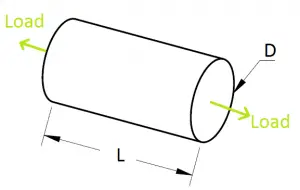Poisson ratio is used to measure the Poisson effect. which is the phenomenon of the behaviour of the material tends to expand in the perpendicular direction to the applied load. Here is the straight definition of the Poisson ratio
Mathematically Poisson ratio is expressed as the ratio of Lateral strain to its Linear (Longitudinal) Strain
When a material is subjected to loading, within the elastic limit, then the ratio of lateral strain to it’s to the Linear(longitudinal) strain is constant. This ratio is called Poisson’s ratio.![]()
It is Denoted by “µ”
The Poisson’s ratio value ranges from 0.1 to 0.5
Understanding Poisson’s ratio
Consider a rod of length L, Diameter D and two forces acting at the ends of the Rod as shown in the figure. Then there would be deformation in the length and the diameter of the rod.
See the Gif image below. The changed Length and diameter would be ΔL and ΔD respectively.
Then,
Lateral Strain is the ratio of Change in diameter(ΔD) to its original diameter(D).
In Pull type of load, the diameter goes on decreasing, so it will be negative(-ve).
Linear(Longitudinal) Strain is the ratio of Change in Length(ΔL) to original length (L).
In Pull type of load, the length goes on increasing, so it will be negative(+ve).
Poisson ratio of some Important Material
Steel Poisson ratio = 0.29
Stainless steel Poisson ratio= 0.3
Aluminium Poisson ratio= 0.35
Copper Poisson ratio= 0.37
Lead Poisson ratio= 0.44
Rubber Poisson ratio= 0.48 to 0.5
Cork poisson’s ratio= 0.5


Leave a Reply